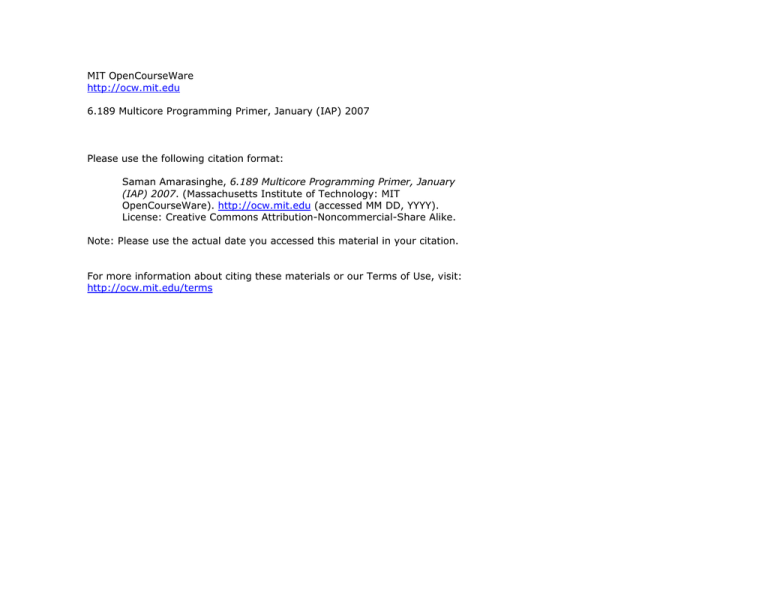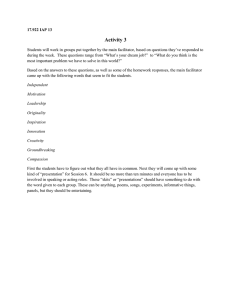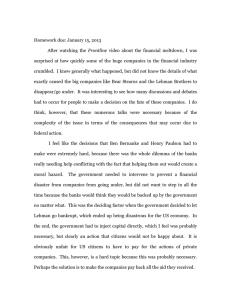MIT OpenCourseWare 6.189 Multicore Programming Primer, January (IAP) 2007
advertisement

MIT OpenCourseWare
http://ocw.mit.edu
6.189 Multicore Programming Primer, January (IAP) 2007
Please use the following citation format:
Saman Amarasinghe, 6.189 Multicore Programming Primer, January
(IAP) 2007. (Massachusetts Institute of Technology: MIT
OpenCourseWare). http://ocw.mit.edu (accessed MM DD, YYYY).
License: Creative Commons Attribution-Noncommercial-Share Alike.
Note: Please use the actual date you accessed this material in your citation.
For more information about citing these materials or our Terms of Use, visit:
http://ocw.mit.edu/terms
6.189 IAP 2007
Lecture 4
Concurrent Programming
Prof. Saman Amarasinghe, MIT.
1
6.189 IAP 2007 MIT
In this lecture…
● Study concurrent programming with an emphasis on correctness
• Parallel programs have the same correctness issues
● Start with a simpler and easier machine/programming model
• • Use Java as a language
Use an Abstract Shared Memory Machine Model
● Next Lecture..
• • • Use C/C++ primitives (MPI)
Study parallel programming with an emphasis on performance
Using a distributed memory machine
Prof. Saman Amarasinghe, MIT.
2
6.189 IAP 2007 MIT
What is concurrency? ● What is a sequential program?
•
A single thread of control that executes one instruction and when it is
finished execute the next logical instruction
● What is a concurrent program?
•
A collection of autonomous sequential threads, executing (logically) in
parallel
● The implementation (i.e. execution) of a collection of threads can be:
Multiprogramming
–
Threads multiplex their executions on a single processor.
Multiprocessing
–
Threads multiplex their executions on a multiprocessor or a multicore system
Distributed Processing
–
Processes multiplex their executions on several different machines
Prof. Saman Amarasinghe, MIT.
3
6.189 IAP 2007 MIT
Concurrency and Parallelism
● Concurrency is not (only) parallelism
A
● Interleaved Concurrency
•
•
Logically simultaneous processing
Interleaved execution on a single
processor
• C
Time
● Parallelism
• B
A
Physically simultaneous processing
Requires a multiprocessors or a
multicore system
B
C
Time
Prof. Saman Amarasinghe, MIT.
4
6.189 IAP 2007 MIT
Account and Bank
import java.util.*;
import java.util.*;
public class Account {
String id;
String password;
int balance;
public class Bank {
HashMap<String, Account> accounts;
static Bank theBank = null;
private Bank() {
accounts = new HashMap<String, Account>();
}
Account(String id, String password, String balance) {
this.id = id;
this.password = password;
this.balance = balance;
}
public static Bank getbank() {
if (theBank == null)
theBank = new Bank();
return theBank;
}
boolean is_password(String password) {
return password == this.password;
}
int getbal() {
return balance;
}
}
void post(int v) {
balance = balance + v;
}
public Account get(String ID) {
return accounts.get(ID);
}
…
}
Prof. Saman Amarasinghe, MIT.
5
6.189 IAP 2007 MIT
ATM
import java.util.*;
import java.io.*;
public class ATM {
static Bank bnk;
PrintStream out;
BufferedReader in;
ATM(PrintStream out, BufferedReader in) {
this.out = out;
this.in = in;
}
public static void main(String[] args) {
bnk = Bank.getbank();
BufferedReader stdin = new BufferedReader
(new InputStreamReader(System.in));
ATM atm = new ATM(System.out, stdin);
atm.run();
}
}
Prof. Saman Amarasinghe, MIT.
6
public void run() {
while(true) {
try {
out.print("Account ID > “ );
String id = in.readLine();
String acc = bnk.get(id);
if (acc == null) throw new Exception();
out.print("Password > “ );
String pass = in.readLine();
if (!acc.is_password(pass))
throw new Exception();
out.print(“your balance is “ + acc.getbal());
out.print("Deposit or withdraw amount > “ );
int val = in.read();
if (acc.getbal() + val > 0)
acc.post(val);
else
throw new Exception();
out.print(“your balance is “ + acc.getbal());
} catch(Exception e) {
out.println("Invalid input, restart“ );
}
}
}
6.189 IAP 2007 MIT
Activity trace
ATM Account ID >
allyssa
Password >
Time
MITROCKS
Your account balance is 1000
Deposit or Withdraw amount >
-200
Your account balance is 800
Prof. Saman Amarasinghe, MIT.
7
6.189 IAP 2007 MIT
ATM
import java.util.*;
import java.io.*;
public class ATM {
static Bank bnk;
PrintStream out;
BufferedReader in;
ATM(PrintStream out, BufferedReader in) {
this.out = out;
this.in = in;
}
public static void main(String[] args) {
bnk = Bank.getbank();
BufferedReader stdin = new BufferedReader
(new InputStreamReader(System.in));
ATM atm = new ATM(System.out, stdin);
atm.run();
}
}
public void run() {
while(true) {
try {
out.print("Account ID > “ );
String id = in.readLine();
String acc = bnk.get(id);
if (acc == null) throw new Exception();
out.print("Password > “ );
String pass = in.readLine();
if (!acc.is_password(pass))
throw new Exception();
out.print(“your balance is “ + acc.getbal());
out.print("Deposit or withdraw amount > “
);
int val = in.read();
if (acc.getbal() + val > 0)
acc.post(val);
else
throw new Exception();
out.print(“your balance is “ + acc.getbal());
} catch(Exception e) {
out.println("Invalid input, restart“ );
}
}
}
I need to run multiple ATM machines from my program, how do I do that?
Prof. Saman Amarasinghe, MIT.
8
6.189 IAP 2007 MIT
Concurrency in Java
● Java has a predefined class java.lang.Thread which provides
the mechanism by which threads are created
public class MyThread extends Thread {
public void run() {
}
}
● However to avoid all threads having to be subtypes of Thread, Java
also provides a standard interface
public interface Runnable {
public void run();
}
● Hence, any class which wishes to express concurrent execution
must implement this interface and provide the run method
● Threads do not begin their execution until the start method in the
Thread class is called
Prof. Saman Amarasinghe, MIT.
9
6.189 IAP 2007 MIT
Why use Concurrent Programming?
● Natural Application Structure
The world is not sequential! Easier to program multiple
independent and concurrent activities.
● Increased application throughput and responsiveness
• Not blocking the entire application due to blocking IO
● Performance from multiprocessor/multicore hardware
• Parallel execution
● Distributed systems
• Single application on multiple machines
• Client/server type or peer-to-peer systems
•
Prof. Saman Amarasinghe, MIT.
10
6.189 IAP 2007 MIT
Multiple ATMs
import java.util.*;
import java.io.*;
public class ATM {
static Bank bnk;
PrintStream out;
BufferedReader in;
ATM(PrintStream out, BufferedReader in) {
this.out = out;
this.in = in;
}
public static void main(String[] args) {
bnk = Bank.getbank();
BufferedReader stdin = new BufferedReader
(new InputStreamReader(System.in));
ATM atm = new ATM(System.out, stdin);
atm.run();
}
}
public void run() {
while(true) {
try {
out.print("Account ID > “ );
String id = in.readLine();
String acc = bnk.get(id);
if (acc == null) throw new Exception();
out.print("Password > “ );
String pass = in.readLine();
if (!acc.is_password(pass))
throw new Exception();
out.print(“your balance is “ + acc.getbal());
out.print("Deposit or withdraw amount > “ );
int val = in.read();
if (acc.getbal() + val > 0)
acc.post(val);
else
throw new Exception();
out.print(“your balance is “ + acc.getbal());
} catch(Exception e) {
out.println("Invalid input, restart“ );
}
}
}
I need to run multiple ATM machines from my program, how do I do that?
Prof. Saman Amarasinghe, MIT.
11
6.189 IAP 2007 MIT
Multiple ATMs
import java.util.*;
import java.io.*;
public void run() {
while(true) {
try {
public class ATMs extends Thread {
out.print("Account ID > “ );
static final int numATMs = 4;
String id = in.readLine();
static Bank bnk;
String acc = bnk.get(id);
PrintStream out;
if (acc == null) throw new Exception();
BufferedReader in;
out.print("Password > “ );
int atmnum;
String pass = in.readLine();
if (!acc.is_password(pass)) ATMs(int num, PrintStream out, BufferedReader in) {
throw new Exception();
this.out = out;
out.print(“your balance is “ + acc.getbal());
this.in = in;
out.print("Deposit or withdraw amount > “ );
this.atmnum = num;
int val = in.read();
}
if (acc.getbal() + val > 0) acc.post(val);
public static void main(String[] args) {
else
bnk = Bank.getbank();
throw new Exception();
ATMs atm[] = new ATMs[numATMs];
out.print(“your balance is “ + acc.getbal());
for(int i=0; i<numATMs; i++){
} catch(Exception e) {
atm[i] = new ATMs(i, outdevice(i), indevice(i));
out.println("Invalid input, restart“ );
atm[i].start();
}
}
}
}
}
}
I need to run multiple ATM machines from my program, how do I do that?
Prof. Saman Amarasinghe, MIT.
12
6.189 IAP 2007 MIT
Activity trace
ATM 1
ATM 2
Account ID >
Account ID >
allyssa
Password >
ben
Password >
Time
MITROCKS
Your account balance is 1000
Deposit or Withdraw amount >
6189cell
Your account balance is 100
Deposit or Withdraw amount >
20
Your account balance is 120
-200
Your account balance is 800
Prof. Saman Amarasinghe, MIT.
13
6.189 IAP 2007 MIT
Activity trace II
ATM 1
ATM 2
Account ID >
Account ID >
ben
Password >
ben
Password >
Time
6189cell
Your account balance is 100
Deposit or Withdraw amount >
0
9
-
0
9
-
!
!
!
0
1
=
6189cell
Your account balance is 100
Deposit or Withdraw amount >
-90
Your account balance is 10
-90
Your account balance is 10
0
0
1
Prof. Saman Amarasinghe, MIT.
14
6.189 IAP 2007 MIT
Activity trace II
balance
100
ATM 1
ATM 2
out.print(“your balance is “ + acc.getbal());
Your account balance is 100
out.print(“your balance is “ + acc.getbal());
Your account balance is 100
out.print("Deposit or withdraw amount > “);
Deposit or Withdraw amount >
-90
-90
int val = in.read();
100
int val = in.read();
if (acc.getbal() + val > 0)
100
10
10
out.print("Deposit or withdraw amount > “);
Deposit or Withdraw amount >
if (acc.getbal() + val > 0)
acc.post(val);
acc.post(val);
out.print(“your balance is “ + acc.getbal());
Your account balance is 10
Prof. Saman Amarasinghe, MIT.
15
out.print(“your balance is “ + acc.getbal());
Your account balance is 10
6.189 IAP 2007 MIT
Activity trace II
balanc
e
ATM 1
100
void post(int v) {
balance = balance + v
ATM 2
-90
balance = balance + v
100 +
balance = balance
100
100
-90
10
v
10
10
void post(int v) {
balance = balance + v
balance = balance + v
100 + v
balance = balance
balance = balance10
+ v;
10
balance = balance + v;
10
}
}
Prof. Saman Amarasinghe, MIT.
16
6.189 IAP 2007 MIT
Synchronization
● All the interleavings of the threads are NOT
acceptable correct programs.
● Java provides synchronization mechanism to restrict
the interleavings
● Synchronization serves two purposes:
• Ensure safety for shared updates
–
• Avoid race conditions
Coordinate actions of threads
–
–
Parallel computation
Event notification
Prof. Saman Amarasinghe, MIT.
17
6.189 IAP 2007 MIT
Safety
● Multiple threads access shared resource
simultaneously
● Safe only if:
• All accesses have no effect on resource,
–
e.g., reading a variable,
or
• All accesses idempotent
–
E.g., y = sign(a), a = a*2;
or
• Only one access at a time:
mutual exclusion
Prof. Saman Amarasinghe, MIT.
18
6.189 IAP 2007 MIT
Safety: Example
● “The too much milk problem”
Milk
Vitamin
D
Image by MIT OpenCourseWare.
Milk
Vitamin
D
Image by MIT OpenCourseWare.
● Model of need to synchronize activities
Prof. Saman Amarasinghe, MIT.
Courtesy of Emery Berger @ UMASS
19
6.189 IAP 2007 MIT
Why You Need Locks
thread A
thread B
if (no milk && no note)
leave note
buy milk
remove note
if (no milk && no note)
leave note
buy milk
remove note
Milk
Milk
Vitamin
D
Vitamin
D
Image by MIT OpenCourseWare.
Image by MIT OpenCourseWare.
● Does this work?
too much milk
Prof. Saman Amarasinghe, MIT.
20
6.189 IAP 2007 MIT
Mutual Exclusion
● Prevent more than one thread from accessing critical
section at a given time
•
•
•
Once a thread is in the critical section, no other thread
can enter that critical section until the first thread has left
the critical section.
No interleavings of threads within the critical section
Serializes access to section
synchronized int getbal() {
return balance;
}
synchronized void post(int v) {
balance = balance + v;
}
Prof. Saman Amarasinghe, MIT.
21
6.189 IAP 2007 MIT
Activity trace II zoomed-in
balance
ATM 1
ATM 2
100
int val = in.read();
int val = in.read();
if (acc.getbal() + val > 0)
100
100
if (acc.getbal() + val > 0)
100
10
!
e
c
n
a
l
Ba
acc.post(val);
acc.post(val);
k
n
a
B
e
-80
v
i
t
a is -80
Your account balance
g
e
N
out.print(“your balance is “ + acc.getbal());
Your account balance is -80
out.print(“your balance is “ + acc.getbal());
Prof. Saman Amarasinghe, MIT.
22
6.189 IAP 2007 MIT
Atomicity
● Synchronized methods execute the body as an atomic unit ● May need to execute a code region as the atomic unit
● Block Synchronization is a mechanism where a region of
code can be labeled as synchronized
● The synchronized keyword takes as a parameter an object
whose lock the system needs to obtain before it can
continue
● Example:
synchronized (acc) {
if (acc.getbal() + val > 0)
acc.post(val);
else
throw new Exception();
out.print(“your balance is “ + acc.getbal());
}
Prof. Saman Amarasinghe, MIT.
23
6.189 IAP 2007 MIT
Synchronizing a block
import java.util.*;
import java.io.*;
public class ATMs extends Thread {
static final int numATMs = 1;
static Bank bnk;
PrintStream out;
BufferedReader in;
int atmnum;
ATMs(int num, PrintStream out, BufferedReader in) {
this.out = out;
this.in = in;
this.atmnum = num;
}
public static void main(String[] args) {
bnk = Bank.getbank();
ATMs atm[] = new ATMs[numATMs];
for(int i=0; i<numATMs; i++){
atm[i] = new ATMs(i, outdevice(i), indevice(i));
atm[i].start();
}
}
}
Prof. Saman Amarasinghe, MIT.
24
public void run() {
while(true) {
try {
out.print("Account ID > “ );
String id = in.readLine();
String acc = bnk.get(id);
if (acc == null) throw new Exception();
out.print("Password > “ );
String pass = in.readLine();
if (!acc.is_password(pass))
throw new Exception();
out.print(“your balance is “ + acc.getbal());
out.print("Deposit or withdraw amount > “ );
int val = in.read();
synchronized (acc) {
if (acc.getbal() + val > 0)
acc.post(val);
else
throw new Exception();
out.print(“your balance is “ + acc.getbal());
}
} catch(Exception e) {
out.println("Invalid input, restart“ );
}
}
}
6.189 IAP 2007 MIT
Activity trace II
balance
ATM 1
ATM 2
out.print(“your balance is “ + acc.getbal());
Your account balance is 100
100
100
out.print(“your balance is “ + acc.getbal());
Your account balance is 100
out.print("Deposit or withdraw amount > “);
Deposit or Withdraw amount >
out.print("Deposit or withdraw amount > “);
Deposit or Withdraw amount >
-90
-90
int val = in.read();
100
100
10
10
10
int val = in.read();
, !
0
0 w
1
a
s
r
w hd
o
h it
your balance is
s
w
e
c ’t
n
n
a
l
d
l
a
u
B co
t
u
b
synchronized(acc)
if (acc.getbal() + val > 0)
acc.post(val);
out.print(“
“ + acc.getbal());
Your account balance is 10
Prof. Saman Amarasinghe, MIT.
25
synchronized(acc)
if (acc.getbal() + val > 0)
throw new Exception()
6.189 IAP 2007 MIT
Synchronizing a block
import java.util.*;
import java.io.*;
public class ATMs extends Thread {
static final int numATMs = 1;
static Bank bnk;
PrintStream out;
BufferedReader in;
int atmnum;
ATMs(int num, PrintStream out, BufferedReader in) {
this.out = out;
this.in = in;
this.atmnum = num;
}
public static void main(String[] args) {
bnk = Bank.getbank();
ATMs atm[] = new ATMs[numATMs];
for(int i=0; i<numATMs; i++){
atm[i] = new ATMs(i, outdevice(i), indevice(i));
atm[i].start();
}
}
}
Prof. Saman Amarasinghe, MIT.
26
public void run() {
while(true) {
try {
out.print("Account ID > “ );
String id = in.readLine();
String acc = bnk.get(id);
if (acc == null) throw new Exception();
out.print("Password > “ );
String pass = in.readLine();
if (!acc.is_password(pass))
throw new Exception();
synchronized (acc) {
out.print(“your balance is “ + acc.getbal());
out.print("Deposit or withdraw amount > “ );
int val = in.read();
if (acc.getbal() + val > 0) acc.post(val);
else
throw new Exception();
out.print(“your balance is “ + acc.getbal());
}
} catch(Exception e) {
out.println("Invalid input, restart“ );
}
}
}
6.189 IAP 2007 MIT
Activity trace II
ATM 1
ATM 2
Account ID >
Account ID >
ben
Password >
ben
Password >
6189cell
6189cell
SP
out.print("Deposit or withdraw amount > “);
Deposit or Withdraw amount >
synchronized(acc)
O
N
SE
synchronized(acc)
out.print(“your balance is “ + acc.getbal());
Your account balance is 100
Image by MIT OpenCourseWare.
N
O
RE
Image removed due to copyright restrictions.
-90
Prof. Saman Amarasinghe, MIT.
27
6.189 IAP 2007 MIT
Account transfers
public boolean transfer(Account from, Account to, int val) {
synchronized(from) {
if (from.getbal() > val)
from.post(-val);
else
throw new Exception();
synchronized(to) {
to.post(val);
}
}
}
Prof. Saman Amarasinghe, MIT.
28
6.189 IAP 2007 MIT
Account Transfers
Allyssa wants to transfer $10 to Ben’s account
While Ben wants to also transfer $20 to Allyssa’s account
AllyssaÆBen
BenÆAllysa
synchronized(from) if (from.getbal() > val)
from.post(-val);
synchronized(from)
if (from.getbal() > val)
from.post(-val);
synchronized(to)
Waiting for Ben’s account
DEA
to be released to perform
Prof. Saman Amarasinghe, MIT.
DLO
CKE
29
synchronized(to)
Waiting for Allyssa’s account
to be released to perform
D!
6.189 IAP 2007 MIT
Avoiding Deadlock
● Cycle in locking graph = deadlock
● Standard solution:
canonical order for locks
• • Acquire in increasing order
Release in decreasing order
● Ensures deadlock-freedom, but not always easy to do
Prof. Saman Amarasinghe, MIT.
30
6.189 IAP 2007 MIT
Account and Bank
public class Account {
String id;
String password;
int balance;
static int count;
…
public boolean transfer(Account from,
Account to,
int val) {
Account(String id,
String password,
String balance) {
this.id = id;
this.password = password;
this.balance = balance;
}
…
}
…
}
Prof. Saman Amarasinghe, MIT.
synchronized(from) {
synchronized(to) {
if (from.getbal() > val)
from.post(-val);
else
throw new Exception();
to.post(val);
}
}
31
6.189 IAP 2007 MIT
Account and Bank
public class Account {
String id;
String password;
int balance;
static int count;
public int rank;
…
public boolean transfer(Account from,
Account to,
int val) {
Account first = (from.rank > to.rank)?from:to;
Account second = (from.rank > to.rank)?to:from;
synchronized(first) {
synchronized(second) {
if (from.getbal() > val)
from.post(-val);
else
throw new Exception();
to.post(val);
}
}
Account(String id,
String password,
String balance) {
this.id = id;
this.password = password;
this.balance = balance;
rank = count++;
}
…
}
}
…
Prof. Saman Amarasinghe, MIT.
32
6.189 IAP 2007 MIT
Races Race conditions – insidious bugs
• • • Non-deterministic, timing dependent
Cause data corruption, crashes
Difficult to detect, reproduce, eliminate
● Many programs contain races
• • Inadvertent programming errors
Failure to observe locking discipline
Prof. Saman Amarasinghe, MIT.
33
6.189 IAP 2007 MIT
Data Races
● A data race happens when two threads access a
variable simultaneously, and one access is a write
int t1;
t1= hits;
hits= t1+1;
Prof. Saman Amarasinghe, MIT.
int t2;
t2=hits;
hits=t2+1;
34
6.189 IAP 2007 MIT
Data Races
● A data race happens when two threads access a
variable simultaneously, and one access is a write
int t1;
int t2;
t2=hits;
hits=t2+1;
t1= hits;
hits= t1+1;
Prof. Saman Amarasinghe, MIT.
35
6.189 IAP 2007 MIT
Data Races
● A data race happens when two threads access a
variable simultaneously, and one access is a write
int t1;
t1= hits;
hits= t1+1;
int t2;
t2=hits;
hits=t2+1;
Prof. Saman Amarasinghe, MIT.
36
6.189 IAP 2007 MIT
Data Races
● Problem with data races:
non-determinism
• Depends on interleaving of threads
● Usual way to avoid data races:
mutual exclusion
• Ensures serialized access of all the shared objects
Prof. Saman Amarasinghe, MIT.
37
6.189 IAP 2007 MIT
Dining Philosophers Problem
● There are 5 philosophers sitting at a round
table.
● Between each adjacent pair of philosophers is a
chopstick.
● Each philosopher does two things: think and
eat.
The philosopher thinks for a while.
When the philosopher becomes hungry, she
stops thinking and…
–
–
–
Image by MIT OpenCourseWare.
Picks up left and right chopstick
He cannot eat until he has both chopsticks, has to
wait until both chopsticks are available
When the philosopher gets the two chopsticks she
eats
When the philosopher is done eating he puts
down the chopsticks and begins thinking again.
Prof. Saman Amarasinghe, MIT.
38
6.189 IAP 2007 MIT
Dining Philosophers Problem Setup
import java.io.*;
import java.util.*;
public static void main(String[] args) {
Philosopher phil[] = new Philosopher[count];
public class Philosopher extends Thread {
static final int count = 5;
Chopstick left;
Chopstick right;
int position;
Chopstick last = new Chopstick();
Chopstick left = last;
for(int i=0; i<count; i++){
Chopstick right = (i==count-1)?last :
new Chopstick();
phil[i] = new Philosopher(i, left, right);
left = right;
}
Philosopher(int position,
Chopstick left,
Chopstick right) {
this.position = position;
this.left = left;
this.right = right;
}
}
}
Prof. Saman Amarasinghe, MIT.
39
for(int i=0; i<count; i++){
phil[i].start();
}
…
6.189 IAP 2007 MIT
Dining Philosophers Problem: Take I
public void run() {
try {
while(true) {
1
synchronized(left) {
2
synchronized(right) {
3
System.out.println(times + ": Philosopher " + position + " is done eating");
}
}
}
} catch (Exception e) {
System.out.println("Philosopher " + position + "'s meal got disturbed");
}
}
Prof. Saman Amarasinghe, MIT.
40
6.189 IAP 2007 MIT
Dining Philosophers Problem: Take II
static Object table;
public void run() {
try {
while(true) {
1
synchronized(table) {
2
synchronized(left) {
3
synchronized(right) {
4
System.out.println(times + ": Philosopher " + position + " is done eating");
}
}
}
}
} catch (Exception e) {
System.out.println("Philosopher " + position + "'s meal got disturbed");
}
}
Prof. Saman Amarasinghe, MIT.
41
6.189 IAP 2007 MIT
Dining Philosophers Problem: Take III
public void run() {
try {
Chopstick first = (position%2 == 0)?left:right;
Chopstick second = (position%2 == 0)?right:left;
1
2
3
}
while(true) {
synchronized(first) {
synchronized(second) {
System.out.println(times + ": Philosopher " + position + " is done eating"
}
}
}
} catch (Exception e) {
System.out.println("Philosopher " + position + "'s meal got disturbed");
}
Prof. Saman Amarasinghe, MIT.
42
6.189 IAP 2007 MIT
Other types of Synchronization
● There are a lot of ways to use Concurrency in Java
• • • • • • • • Semaphores
Blocking & non-blocking queues
Concurrent hash maps
Copy-on-write arrays
Exchangers
Barriers
Futures
Thread pool support
Prof. Saman Amarasinghe, MIT.
43
6.189 IAP 2007 MIT
Potential Concurrency Problems
● Deadlock
• Two or more threads stop and wait for each other
● Livelock
•
Two or more threads continue to execute, but make
no progress toward the ultimate goal.
● Starvation
•
Some thread gets deferred forever.
● Lack of fairness
•
Each thread gets a turn to make progress.
● Race Condition
•
Some possible interleaving of threads results in an
undesired computation result.
Prof. Saman Amarasinghe, MIT.
44
6.189 IAP 2007 MIT
Conclusion
● Concurrency and Parallelism are important concepts
in Computer Science
● Concurrency can simplify programming
•
However it can be very hard to understand and debug
concurrent programs
● Parallelism is critical for high performance
•
From Supercomputers in national labs to Multicores and GPUs on your desktop
● Concurrency is the basis for writing parallel programs
● Next Lecture: How to write a Parallel Program
Prof. Saman Amarasinghe, MIT.
45
6.189 IAP 2007 MIT



